SOLAR SYSTEM FAMILY-FACTS ABOUT THE MAJOR MOONS OF SATURN
There is some visible competition among the planets in our solar system as every single one of them is desperate to show their uniqueness. Thereby, instead of being the most beautiful planet with a dazzling set of rings, Saturn decided to outnumber others in terms of natural satellites. Some of its 82 confirmed moons are regular satellites with well-defined orbits, while others are captured objects, moonlets, or trojan bodies having highly irregular and inclined orbits. The Saturnian system is indeed a unique place for any interplanetary traveler, worlds like Mimas, Enceladus, Tethys, Dione, Rhea, Titan, Hyperion and Iapetus require a special ticket.
Discovery: During the 17th and 18th century, in the absence of modern telescopes and powerful gadgetries, the early astronomers took the painstaking job of manually scanning the skies night after night to unlock the secrets of the cosmos. In this way, the second-largest moon in our solar system, i.e., Titan, the first Saturnian moon, was discovered by Christiaan Huygens in 1655. Tethys, Dione, Rhea and Iapetus, were discovered by Giovanni Domenic Cassini from 1671-1684. Mimas and Enceladus by William Hershel in 1789 and finally, Hyperion by G.P. Bond, W.C. Bond and William Lassell. In 1899, W.H Pickering introduced a new imaging technique and discovered Phoebe, which became the ninth satellite of the ringed planet. Janus and Epimetheus were discovered by Audouin Dollfus in 1966. A lot more were found by the unmanned Voyager missions. Finally, with the recent discovery of 20 additional moons, Saturn became the only planet in our solar system with the most moons.
Formation: Scientists are not sure about the formation of the Saturnian or for that matter, the Jovian system of moons and certain questions remain unanswered to this date. It is however assumed that some moons formed directly from the accretion of nebular materials, while the rest were gravitationally captured.
Mimas: Named after a son of Gaia(personification of Earth as per Greek Mythology), Mimas is the smallest astronomical body in our solar system to retain a spherical shape via self-gravity. With a mean radius of 198 km, Mimas is not large enough to maintain a hydrostatic equilibrium and a mean density of 1.15 g/cc indicates a composition mostly of water ice and a small amount of rock. The Mimantean surface is heavily cratered, of which the Herschel impact crater(diameter=130 km) deserves special mention. Mimas is situated at a mean distance of 186,000 km from its parent planet and takes about 22 hours, 36 minutes to complete a single orbit.
 |
| Mimas and the largest crater-Herschel(to the right)/Image Credits: NASA / JPL-Caltech / Space Science Institute, Public domain, via Wikimedia Commons |
Enceladus: Enceladus is a small moon with a mean diameter of 500 km. It is in a 2:1 mean-motion orbital resonance with Dione, and the former completes its orbit around Saturn in about 32.9 hours. It is situated at an average distance of 238,000 km from Saturn's centre, between the orbits of Mimas and Tethys. High-resolution images from the Voyager data reveals an icy surface adorned with numerous craters, faults, troughs, grooves, ridges, scarps, smooth terrains and other tectonic features. Its interior might have differentiated into a core made up of silicate materials, surrounded by a mantle of water ice. Enceladus emits plumes of gas, dust and water vapour, thereby indicating a subsurface ocean of liquid water and other substances. The materials ejected via these plumes might also be the main reason for the existence of Saturn's E ring.
 |
| Enceladus/Image Credits: National Aeronautics and Space Administration (NASA) / Jet Propulsion Laboratory (JPL), Public domain, via Wikimedia Commons |
Tethys: Named after a Titaness from Greek mythology, Tethys, the third Saturnian moon is situated at an average distance of 295,000 km from the planet's centre, having an orbital period of 45 hours. Having a mean diameter of 1060 km, it is the largest among all the inner moons. A lower density of 0.98g/cc indicates a composition mostly of water ice with a small fraction of rocky materials. The surface is heavily cratered with the largest one being the Odysseus(diameter=450 km). Apart from that there is a large canyon like valley, the Ithaca Chasma, about 100 km wide, 3 km deep and more than 2000 km long. Its internal structure and compositions are not well known.
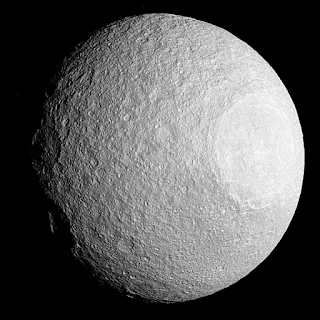 |
| Tethys and the Odysseus Crater(to the right)/Image Credits: NASA/JPL-Caltech/Space Science Institute, Public domain, via Wikimedia Commons |
Dione: Named after another Titaness, Dione is a small, inner moon with a mean diameter of 1124 km, is situated at an average distance of 377,400 km from the planet. It completes its orbit once in 2.7 Earth days and maintains a 1:2 mean motion orbital resonance with Enceladus. A mean density of 1.48 g/cc suggests the presence of a possible silicate-rich rocky core, while the rest is ice. Dione's surface consists of heavy to low cratered terrains, followed by an extensive network of troughs, fractures, depressions, canyons and some other geologic features.
Rhea: Also named after a Titaness, Rhea is the second-largest and the fifth major moon of Saturn. With a mean diameter of 1528 km, it is large enough to maintain a hydrostatic equilibrium. It is situated at an average distance of 527,000 km from the planet's centre and completes an orbit within 4.5 Earth days. It's composition is similar to Dione, with three parts ice and one part rock, and is heavily cratered than Tethys or Dione. Although scientists have discovered a very thin atmosphere of oxygen and carbon dioxide in a world outside Earth, their concentrations are millions or trillions of times lesser than what we have on Earth.
Titan: Titan is the largest natural satellite of Saturn. Having a mean diameter of 5150 km it is also the second-largest moon in our solar system. Situated at an average distance of 1.2 million km from Saturn and being tidally locked with the planet, the former completes a single orbit in about 15 Earth days and 22 hours. Titan has an extremely thick atmosphere, composed of 97% nitrogen, 2.7% methane, and traces of hydrogen, helium, carbon dioxide, carbon monoxide, followed by hydrocarbons like ethane, acetylene, propane, etc. These gases react with the incoming solar radiation and other energetic particles from Saturn's magnetosphere to form a thick layer of heavy smog which blankets the underlying surface features. But infrared imagery has revealed an Earth-like surface, with lakes, and rivers filled with liquid hydrocarbons, sand dunes and rocks of water ice and solidified hydrocarbons. Apart from that, there are impact craters, mountains, hills, valleys and other geologic features. The largest lake is the Kraken Mare, filled with liquid methane instead of liquid water. The icy surface records an average temperature of 93 K. Scientists estimate that Titan might possess a differentiated interior and subsurface ocean of liquid water.
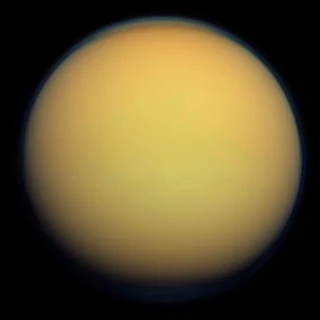 |
| Titan and its orange hue/Image Credits: NASA/JPL-Caltech/Space Science Institute, Public domain, via Wikimedia Commons |
Hyperion: Hyperion is rather small with a highly irregular shape and a mean diameter of only 270 km. It is in a 4:3 mean-motion orbital resonance with Titan, i.e., for every three revolutions completed by Hyperion, the latter completes four. Hyperion is situated at an average distance of 1.5 million km from Saturn in an highly eccentric orbit with an orbital period of 21 days and an axial rotation period of 13 days. High-resolution images from the Cassini spacecraft reveals a heavily cratered surface. Its low density and somewhat porous structure indicates an icy composition with a very small fraction of rocky materials.
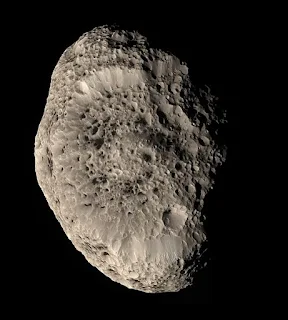 |
| The irregularly shaped Hyperion/Image Credits: NASA / JPL / SSI / Gordan Ugarkovic, Public domain, via Wikimedia Commons |
Iapetus: With a mean diameter of 1470 km, Iapetus is the third-largest moon of Saturn. In spite of being situated at an average distance of 3.5 million km from the planet, it is tidally locked and completes an orbit once in every 79 days. Because of being in an orbital resonance with Titan, Iapetus experiences some gravitational perturbations. The most notable feature of Iapetus is its two-tone colouration as the side that faces the planet is dark, while the opposite side is white. Close-up images reveal a heavily cratered surface and an equatorial ridge across the dark hemisphere, thereby giving this moon some of the tallest mountains in our solar system. A possible explanation for the colour contrast is the deposit of debris from the massive Phoebe ring that dwarfs the main rings of Saturn. Apart from that, a runaway process of ice sublimation deposits ice on the opposite side thereby, giving it a colour like fresh snow.
 |
| Iapetus and its two tone colouration/Image Credits: NASA/JPL/Space Science Institute, Public domain, via Wikimedia Commons |
Explorations: With the advent of space exploration and modern telescopes, the Saturnian system was explored in further detail. The Pioneer Mission, the Voyager Mission and the Cassini-Huygens mission gathered a load of interesting data about these distant worlds.
Life & Biological Considerations: The Saturnian moons are frigid worlds with temperatures going as low as 90 K(-183℃). So life as we know it may not be able to survive these harsh conditions. But life as we don't know it might develop a different biology and thrive in the subsurface oceans and particularly in the hydrocarbon lakes of Titan. It's well known that organic molecules like methane, ethane, and other hydrocarbons, in addition to ammonia, carbon dioxide and a little amount of solar radiation can kick-start the synthesis of complex organic molecules. However, current conditions are probably too harsh for any sort of life, even for all sorts of exotic alien life. But scientists believe that five billion years from now, when the Sun evolves into a red giant star, Titan might receive the sufficient amount of solar radiation to raise its frigid surface temperatures and develop conditions more suitable for living organisms.
 |
| Saturn's rings and the location of its moons/Image Credits: NASA/JPL, Public domain, via Wikimedia Commons |
Some Interesting Facts: Here are some interesting things to learn about the Saturnian system.
- Co-orbital Moons: Janus and Epimetheus, frequently called the dancing moons of Saturn, are co-orbital moons with a very small difference in their semi major axis. As a result, every four years, one moves closer to the planet while the other moves farther away, as if they are in an orbital ballet swapping their positions.
- Irregular Moons: A plethora of smaller satellites with highly inclined orbits, large orbital radii and compositions similar to that of asteroids form the irregular moons. These include the Norse Group, the Inuit Group and the Gallic Group, among which Phoebe deserves a special mention. Phoebe is the largest among the irregular satellites. It has a mean diameter of 213 km and a heavily cratered surface. It is assumed that Phoebe is probably responsible for creating the largest ring of Saturn, called the Phoebe Ring.
- Ring Moonlets: These are lumps that form due to the accretion of material within the main set of rings. Apart from that there are also ring shepherds, which are tiny moons within the ring system.
- Alkyonides: These are some small inner moons that orbit between Mimas and Enceladus.
- Trojan Moons: Trojan moons are moons that orbit at the Lagrange point of a moon. Tethys and Dione both have Trojan moons.
References:
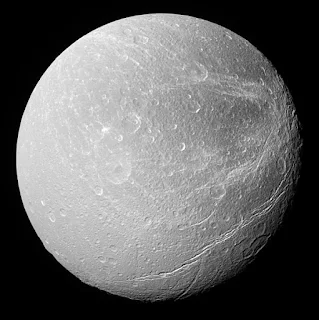
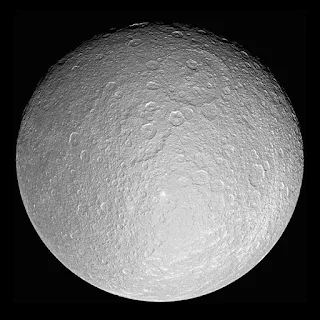


Comments
Post a Comment